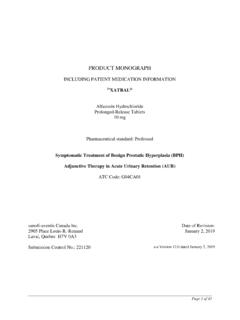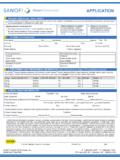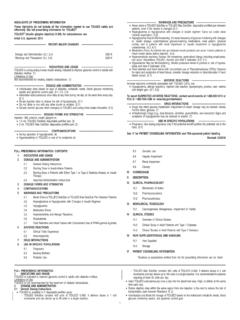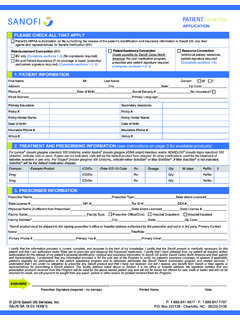Transcription of PRODUCT MONOGRAPH - Sanofi
1 Page 1 of 36 PRODUCT MONOGRAPH PrIMOVANE (zopiclone) Tablets, mg and mg Hypnotic and Sedative Sanofi -aventis Canada Inc. 2905 Place Louis Laval, Quebec H7V 0A3 Date of Revision: May 8, 2017 Submission Control No.: 202617 s-a version dated May 8, 2017 Page 2 of 36 NAME OF DRUG PrIMOVANE (zopiclone) Tablets, mg and mg Hypnotic and Sedative WARNING: RISKS FROM CONCOMITANT USE WITH OPIOIDS Concomitant use of zopiclone and opioids may result in profound sedation, respiratory depression, coma, and death (see WARNINGS, Risks from concomitant use of opioids and benzodiazepines). Reserve concomitant prescribing of these drugs for use in patients for whom alternative treatment options are inadequate. Limit dosages and durations to the minimum required. Follow patients for signs and symptoms of respiratory depression and sedation.
2 ACTIONS, CLINICAL PHARMACOLOGY IMOVANE (zopiclone), a cyclopyrrolone derivative, is a short-acting hypnotic agent. IMOVANE is structurally unrelated to existing hypnotics. However, the pharmacological profile of IMOVANE is similar to that of the benzodiazepines. IMOVANE pharmacological properties are: hypnotic, sedative, anxiolytic, anti-convulsant, muscle-relaxant. These effects are related to a specific agonist action at central receptors belonging to the GABAa macromolecular complex, modulating the opening of the chloride ion channel. In sleep laboratory studies of one to 21-day duration in man, zopiclone reduced sleep latency, increased the duration of sleep and decreased the number of nocturnal awakenings. Zopiclone delayed the onset of REM sleep but did not reduce consistently the total duration of REM periods.
3 The duration of stage 1 sleep was shortened, and the time spent in stage 2 sleep increased. In most studies, stage 3 and 4 sleep tended to be increased, but no change and actual decreases have also been observed. The effect of zopiclone on stage 3 and 4 sleep differs from that of the benzodiazepines, which suppress slow wave sleep. The clinical significance of this finding is not known. With hypnotic drugs, the duration of hypnotic effect and the profile of unwanted effects may be influenced by the alpha (distribution) (t ) and beta (elimination) (t ) half-lives of the administered drug and any active metabolites formed. When half-lives are long, the drug or metabolite may accumulate during periods of nightly administration and be associated with Page 3 of 36 impairments of cognitive and motor performance during waking hours.
4 If half-lives are short, the drug and metabolites will be cleared before the next dose is ingested, and carry-over effects related to sedation or CNS depression should be minimal or absent. If the drug has a very short elimination half-life, it is possible that a relative deficiency ( , in relation to the receptor site) may occur at some point in the interval between each night s use. This sequence of events may account for two clinical findings reported to occur after several weeks of nightly use of rapidly eliminated benzodiazepines or benzodiazepine-like hypnotics: 1) increased wakefulness during the last third of the night and 2) the appearance of increased day-time anxiety (see WARNINGS). During nightly use and for an extended period, pharmacodynamic tolerance or adaptation to some effects of benzodiazepines or benzodiazepine-like hypnotics may develop.
5 However in two sleep laboratory studies involving 17 patients, there was an absence of tolerance with zopiclone for treatment periods of more than 4 weeks. Rebound insomnia: Some manifestations of rebound insomnia have been reported both in sleep laboratory and clinical studies following the withdrawal of zopiclone (see PRECAUTIONS). Zopiclone treatment was associated with dose-related residual effects (see PRECAUTIONS). Pharmacokinetics Absorption: Zopiclone is rapidly and well absorbed. Bioavailability is more than 75%, indicating the absence of a significant first-pass effect. After the administration of and mg doses, peak plasma concentrations of 30 and 60 ng/mL, respectively were reached in less than 2 hours. Absorption was similar in males and females. Repeated daily administration of a mg oral dose for 14 days did not change the pharmacokinetic characteristics of zopiclone and did not lead to accumulation.
6 Distribution: Zopiclone is rapidly distributed from the vascular compartment (distribution half-life [t ]: hours) while the elimination half-life is approximately 5 hours (range: to hours). Plasma protein binding is low (approximately 45% in the 25-100 ng/mL concentration range) and non saturable. The risk of drug interaction arising from displacement of bound drug is low. The distribution volume is liters. Metabolism: Zopiclone is extensively metabolized by three major pathways; only about 4 to 5% of the drug is excreted unchanged in the urine. Page 4 of 36 An in vitro study indicates that cytochrome P450 (CYP) 3A4 is the major isoenzyme involved in the metabolism of zopiclone to both metabolites, and that CYP2C8 is also involved with N-desmethyl zopiclone formation. The principal metabolites are the N-oxide derivative (~12%), which has weak pharmacological activity in animals, and the N-desmethyl metabolite (~16%), which is pharmacologically inactive.
7 Their apparent half-lives evaluated from the urinary data are approximately and hours, respectively. Both metabolites are excreted renally. Other metabolites resulting from oxidative decarboxylation are partly eliminated via the lung as carbon dioxide. In animals, zopiclone did not induce hepatic microsomal enzymes. Excretion: Excretion studies, using C14-zopiclone have shown that more than 90% of the administered dose was excreted over a period of 5 days, 75% being eliminated in the urine and 16% in the feces. The low renal clearance of unchanged zopiclone (mean mL/min) compared with that of plasma (232 mL/min) indicates that zopiclone clearance is mainly metabolic. Special patient population: Elderly subjects: the absolute bioavailability of zopiclone was increased (94% vs 77% in young subjects) and the elimination half-life prolonged (~7 hours).
8 Accumulation has not been observed on repeated dosing. Patients with hepatic insufficiency: elimination half-life was substantially prolonged ( hours) and time to peak plasma levels delayed ( hours). Consequently, lower doses are recommended (see DOSAGE AND ADMINISTRATION). In cirrhotic patients, the plasma clearance of IMOVANE is reduced by approximately 40% in relation with the decrease of the demethylation process. Therefore, dosage will have to be modified in these patients. Patients with mild to moderate renal insufficiency: the pharmacokinetics of zopiclone were not affected. In renal insufficiency, no accumulation of zopiclone or of its metabolites has been detected after prolonged administration. IMOVANE is removed by hemodialysis; however, hemodialysis is of no value in treating overdose due to the large volume of distribution of IMOVANE (see also SYMPTOMS AND TREATMENT OF OVERDOSAGE).
9 Hemodialysis did not appear to increase the plasma clearance of the drug. Page 5 of 36 Lactating women: zopiclone was present in the milk, its concentration paralleled plasma levels but was about 50% lower (see PRECAUTIONS, Use in nursing mothers). INDICATIONS AND CLINICAL USE Sleep disturbance may be the presenting manifestation of a physical and/or psychiatric disorder. Consequently, a decision to initiate symptomatic treatment of insomnia should only be made after the patient has been carefully evaluated. IMOVANE (zopiclone) is indicated for the short-term treatment and symptomatic relief of insomnia characterized by difficulty in falling asleep, frequent nocturnal awakenings and/or early morning awakenings. Treatment with IMOVANE should usually not exceed 7-10 consecutive days. Use for more than 2- 3 consecutive weeks requires complete re-evaluation of the patient.
10 Prescriptions for IMOVANE should be written for short-term use (7-10 days) and it should not be prescribed in quantities exceeding a 1-month supply. The use of hypnotics should be restricted for insomnia where disturbed sleep results in impaired daytime functioning. CONTRAINDICATIONS IMOVANE is contraindicated in patients with: known hypersensitivity to the drug or to any component in its formulation. For a complete listing, see PHARMACEUTICAL INFORMATION, Composition section. myasthenia gravis severe hepatic insufficiency severe impairment of respiratory function ( , significant sleep apnea syndrome). WARNINGS General: Benzodiazepine and benzodiazepine-like compounds should be used with extreme caution in patients with a history of substance or alcohol abuse. Because some of the adverse effects of IMOVANE may be dose related, the smallest possible effective dose should be prescribed, especially for elderly patients.






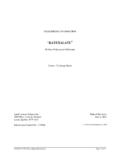
![Thymoglobulin (anti-thymocyte globulin [rabbit]) - …](/cache/preview/a/b/2/e/e/b/8/2/thumb-ab2eeb82468088f352549e7d8dab340f.jpg)



